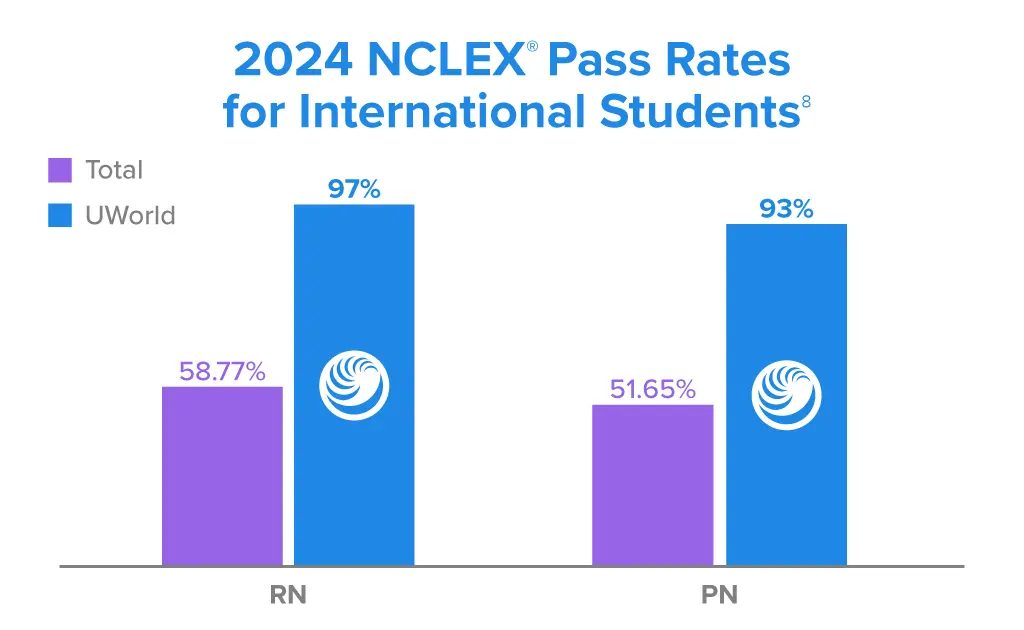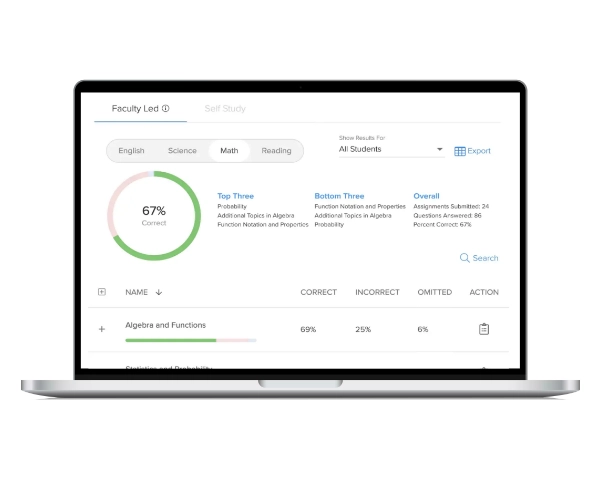The United States faces a persistent nursing shortage, leading healthcare institutions to seek various solutions. One significant strategy is the recruitment of internationally educated nurses (IENs). This raises important questions: What challenges do IENs typically face when integrating into the U.S. healthcare system? How can we effectively support their success?
Addressing Nurse Shortages
Nurse shortages are not exclusive to the United States. However, several compounding factors have worsened the situation. These include an aging U.S. population, a retiring nursing workforce, the impact of COVID-19, high levels of stress and burnout, and shortages of nursing school faculty. As demand for nurses continues to rise, the 2024 CGFNS International (now known as TruMerit) Nurse Migration Report1 revealed a 4.6% decrease in VisaScreen® applications from 2023 to 2024, with a total of 24,733 applications received in 2024.
Key insights from the report include:
- Although the exact percentage of registered nurses (RNs) among VisaScreen applicants for 2024 is not specified, the report emphasizes nurse migration, indicating that RNs likely constitute the majority of applicants.
- 51% of VisaScreen applicants were educated in the Philippines, down from 60% the previous year.
- 76% of VisaScreen applicants sought permanent resident status.
- 92% of VisaScreen certifications were awarded to nurses educated in the top 10 countries.
- Canada now represents 8% of VisaScreen certificates, while Kenya accounts for 6.5%.
- Despite the slight decrease from 2023, the 2024 figure remains nearly 200% higher than the fiscal year 2018 level.
Total VisaScreen® Applications Received1
| Year | Applications |
|---|---|
| 2024 | 24,733 |
| 2023 | 25,935 |
| 2022 | 17,354 |
| 2021 | 12,015 |
| 2020 | 8,586 |
| 2019 | 10,869 |
| 2018 | 8,297 |
*CGFNS International Inc. (CGFNS), now known as TruMerit, is an immigration-neutral, non-profit organization that helps foreign-educated healthcare professionals live and work in their country of choice by assessing and validating their academic and professional credentials.1
Licensure Requirements for International Nurses
To ensure that domestic and IEN nurses are qualified to practice and maintain public safety, the National Council of State Boards of Nursing (NCSBN) has established uniform licensure requirements2 for Boards of Nursing (BONs). These requirements for internationally educated nurses include:
Education Requirements
IENs must graduate from a nursing program equivalent to a member board-approved RN or LPN/VN prelicensure program.
BONs are responsible for verifying program completion, typically through a credential review agency, and ensuring that the program has been properly accredited in the respective country.
NCLEX® Requirements
IENs must successfully pass the NCLEX-RN® or NCLEX-PN® examination. The relevant BON must verify the completion of this requirement.
Additional IEN Requirements
IENs must self-disclose their nursing licensure status from their country of origin, if applicable, and pass a recognized English proficiency exam. Exceptions are made for applicants from English-speaking countries with programs taught in English.
Boards of Nursing must verify an IEN’s licensure status and authorization to practice and confirm that any required English proficiency exams have been successfully completed.
Criminal Background Checks
IENs must self-disclose any misdemeanors, felonies, and plea agreements and undergo state and federal fingerprint checks.
BONs are responsible for individually reviewing all criminal cases. Additionally, they require a psychological evaluation conducted by a board-approved expert for individuals convicted of sexual offenses. Licensure will be denied if the evaluation reveals predatory sexual behaviors.
Substance Use Disorders
IENs must self-disclose any substance use disorders they have experienced in the past 5 years.
BONs will require a substance use disorder evaluation to ensure that the applicant is capable of practicing nursing safely.
Other Licenses, Certifications, and Registrations
IENs must self-disclose any actions taken or initiated against their professional or occupational licenses, registrations, or certifications.
BONs will review these actions and assess the individual's ability to practice nursing safely.
Common Challenges for IENs
In addition to the documentation and processes necessary for immigration and licensure in the United States, internationally educated nurses encounter various cultural and patient care challenges. Recognizing these difficulties can significantly enhance working relationships and improve patient outcomes.
Let’s examine the 3 Cs — communication, culture, and care systems — identified by Meredith Padilla, Ph.D., RN, CCRN-CMC-CSC,3, which many IENs find challenging.
“Working in the U.S., I have experienced nursing care challenges like language barriers, cultural differences, and beliefs and practices regarding health and illness.” — Jaymi C., an Internationally Educated Nurse from the Philippines
Communication Barriers
Nursing is a deeply personal endeavor. Strong verbal and nonverbal communication skills are essential to truly understanding and meeting patient needs. Although internationally educated nurses must pass an English proficiency exam, subtle communication cues, slang, and acronyms can still create barriers to effective communication.
|
Dr. Padilla’s Communication Tips3 “Be patient, an active listener, and supportive.”
|
|
|---|---|
For IENs
|
For Team Members
|
Culture
Starting a new job in a different country can be challenging. Many internationally educated nurses face feelings of loneliness and homesickness, as well as adjusting to unfamiliar foods, climates, and everyday tasks that we often take for granted. Almost every aspect of their work and home environments may be different.
|
Dr. Padilla’s Tips for Cultural Understanding3 |
|
|---|---|
Advice from Established IENs for New IENs
|
General Advice for IENs
|
CARE Systems
The U.S. healthcare system stands out compared to other countries' systems, creating a significant learning curve. Dr. Padilla illustrates this with the acronym “CARE,” which encompasses the following components:3
- Clients: Understanding client roles and rights
- Access: Identifying barriers to treatment
- Roles and Responsibilities: Clarifying the scope of practice
for nurses - Equipment: Utilizing tools and technology for clinical practice
|
Dr. Padilla’s Workplace Tips3 |
|
|---|---|
For IENs
|
For Team Members
|
Bias in the Workplace
Dr. Padilla does not address the issue of bias in the workplace. Bias can be overt or subtle, often stemming from preconceived notions about internationally educated nurses. A prevalent assumption is that IENs may be less educated than their U.S. counterparts, though this may not be true for everyone. By recognizing and acknowledging these preconceived attitudes, we can foster a workplace environment free of bias and inclusive of IENs.
Transition Programs for IENs
Various credential evaluation agencies, staffing firms, universities, and healthcare providers have enhanced their recruitment and training programs to facilitate the transition for IENs living and practicing in the U.S.
Staffing Firms
International staffing and recruiting agencies are vital in assisting IENs with their nursing practice in the U.S. They provide support in several key areas:
- Evaluation Services: Help with CGFNS International education and experience evaluation.
- Visa and Immigration Assistance: Guidance on obtaining visas (e.g., H-1B or permanent resident documentation) to work legally in the U.S.
- Licensing Exam Preparation: Resources and support for preparing for the National Council Licensure Examination for Registered Nurses (NCLEX-RN).
- Job Placement: Matching employment opportunities based on skills, experience, visa sponsorship, location, and assistance in negotiating fair compensation and benefits.
- Orientation and Mentorship: Onboarding programs and mentorship to help IENs transition into U.S. culture.
IENs are encouraged to thoroughly research and compare agencies that align with their personal and professional goals.
Colleges and Universities
In addition to staffing agencies, nursing programs at colleges and universities provide significant support for IENs:
- Bridge Programs: Specifically designed for IENs, these programs bridge the gap between foreign education and U.S. nursing standards, often including coursework, clinical experiences, and NCLEX preparation.
- RN-to-BSN Programs: These programs aid in the transition from an associate degree to a bachelor's degree in nursing, enhancing career advancement and leadership opportunities.
- Scholarship and Financial Aid Programs: Financial assistance can help alleviate the costs associated with additional education and the licensure process.
- Collaboration with Local Healthcare Systems: Partnerships with healthcare institutions often create employment opportunities for IENs.
Nursing programs and healthcare institutions are important in supporting IENs through successful licensure and integration into the U.S. nursing workforce.
Healthcare Providers
Healthcare providers are instrumental in welcoming and supporting IENs post-licensure. They offer support through:
- Mentorship Programs: Pairing IENs with experienced nurses provides essential guidance as they adjust to cultural nuances and the U.S. healthcare system.
- Culturally Sensitive Onboarding and Orientation: It is crucial to address the specific needs of IENs, including cultural differences and language barriers. This may include offering translation services and cultural sensitivity training for staff.
- Ongoing Professional Development: Continuing education opportunities focused on U.S. healthcare regulations, specific specialties, and cultural competence help IENs stay informed and broaden their knowledge.
- Support Groups and Networking Opportunities: These events allow IENs to connect with colleagues, share experiences, and foster community.
Through effective onboarding and professional support programs, healthcare providers can smooth the transition for IENs into their new environment and strengthen their teams.
The Research on Transition Programs
Transition programs for internationally educated nurses have shown promising results. A 2022 study examined the effectiveness of these programs in helping IENs acclimate to the U.S. healthcare system.4 IENs who participated in a 5-week clinical and cultural transition program, which included logistical support for migration, were assessed by nurse leaders after their first 90 days of employment. The findings were encouraging, indicating that transition programs, combined with ongoing support, can enhance the development of IENs as competent care providers and streamline their path to licensure.
“Because we were nurses for over 10 years, we were required to be trained for 1 month only. I would say it really helped since our senior nurses were really accommodating, helpful, understanding, and patient with our learning adjustments.” — Leona O., an IEN from the Philippines
UWorld Nursing’s NCLEX Prep Resources
Limited research has been conducted on how international nursing students adapt to U.S. educational systems and how internationally educated nurses transition into U.S. practice. However, growing evidence suggests that resources such as UWorld can be highly beneficial.
- Our question banks (QBanks) include evolving case studies and practice questions designed to closely resemble the NCLEX format, which has been shown to improve student performance.6
- A cross-sectional survey of internationally educated nurses preparing for licensure in Canada noted a similar trend.7 This study indicated that a combination of professional experience and guided study resources significantly predicts success on first-attempt licensure exams.
Our QBanks specifically cater to this need by providing NCLEX-style questions and detailed answer explanations crafted by practicing nurse educators. Internal data suggests that this evidence-based approach, utilizing NCLEX-style content, enhances students' clinical understanding.
We attribute our enhanced performance to our item development process. While our primary goal is to prepare students from all backgrounds for their licensure exams, our greater focus is on fostering the clinical reasoning and judgment skills essential for providing quality patient care. We accomplish this through:
- Evidence-based, culturally sensitive content that aligns with national clinical standards
- Exam items created by practicing nurse educators from across the U.S. and Canada
- A thorough review process involving nurse and physician panels to ensure accuracy, clinical relevance, and lasting value
- An unbiased, entry-level focus that establishes a strong clinical foundation for nurses from diverse backgrounds and specialties
- Ongoing updates and enhancements to maintain item accuracy and usefulness
I'm a registered nurse here in Zambia, and I recently took my NCLEX exams through my nursing agency in the U.S. I think that UWorld is one of the best, best, best QBanks that one can get. … Their rationales are very brief and straight to the point, easy to understand. Keep practicing, study every day, watch the videos and the rationales that they give. Totally amazing.”
What I like the most about using UWorld is that the wording of these questions was great for me because English is not my first language. So it was really easy for me to understand. I also love the rationales because they really explain why the question is wrong or why the question is right. That was very helpful for the NCLEX.”
I’m from Puerto Rico, so my primary language is Spanish. The style and format of the exams here are not the same. I was pretty scared at first. My favorite part of UWorld was the videos with the rationale and also the short videos of every single topic. That was awesome. It helped me a lot in understanding the pathophysiology, the diagnostics, everything.”
Elevating Patient Experiences
Although IENs may initially struggle with communication and cultural nuances in the workplace, their unique experiences and perspectives provide significant value to the healthcare system. As the U.S. population becomes increasingly diverse, integrating IENs can enhance the patient experience by promoting culturally sensitive care and understanding.
A qualitative study9 explored the potential benefits of internationally educated nurses to the Canadian healthcare system by promoting culturally competent nursing care. Below is a summary of their contributions to patients from diverse ethnic backgrounds:
Benefits of Multilingualism to the Care Team
|
Benefits of Multilingual Support for Patients
|
The major takeaway from this study is that cultural understanding is reciprocal. Teams that leverage the strengths of IENs, such as their fluency in foreign languages and familiarity with various cultural norms, are more likely to enhance the quality of patient care.
“Allowing for new ideas and diverse perspectives can also lead to greater innovation and excellence in nursing.” — Jaymi C., an IEN from the Philippines
Embracing Change for a Positive Future
The role of internationally educated nurses in the healthcare industry contributes diverse perspectives and valuable skills. While bridging communication and cultural gaps may initially present challenges, evidence shows that transition programs and mentorship can facilitate IENs' integration into practice. By welcoming IENs and their unique global viewpoints, nurse leaders and educators can foster mutually beneficial situations in the workplace.
References
- Commission on Graduates of Foreign Nursing Schools. (2024). Nurse migration rates to the U.S. remained high in 2024. https://www.cgfns.org/nurse-migration-rates-to-the-u-s-remained-high-in-2024/
- “Licensure of Internationally Educated Nurses: A Resource Manual.” NCSBN, 2023, www.ncsbn.org/public-files/23_IEN_manual.pdf.
- Padilla, Meredith. “Internationally Educated Nurses’ Experiences Working in the U.S.” American Association of Critical-Care Nurses, 1 May 2023, https://www.aacn.org/blog/internationally-educated-nurses-experiences-working-in-the-us.
- Rovito, Kathy et al. “Enhancing workforce diversity by supporting the transition of internationally educated nurses.” Nursing management vol. 53,2 (2022): 20-27. doi:10.1097/01.NUMA.0000816252.78777.8f
- Newton, Louise et al. “Experiences of registered nurses who supervise international nursing students in the clinical and classroom setting: an integrative literature review.” Journal of clinical nursing vol. 25,11-12 (2016): 1486-500. doi:10.1111/jocn.13127
- Hopkins, Nicole M, and Jennifer M L Stephens. “Education Strategies Supporting Internationally Educated Registered Nurse Students With English as a Second Language in Canada.” The Canadian journal of nursing research = Revue canadienne de recherche en sciences infirmieres vol. 53,2 (2021): 162-170. doi:10.1177/0844562120917254
- Covell, Christine L et al. “Internationally educated nurses in Canada: predictors of workforce integration.” Human resources for health vol. 15,1 26. 4 Apr. 2017, doi:10.1186/s12960-017-0201-8
- IPASS Processing. (2024). Next Gen NCLEX pass rates for the first quarter of 2024. https://ipassprocessing.com/next-gen-nclex-pass-rates-for-the-first-quarter-of-2024/
- Njie-Mokonya, Ndolo. “Internationally Educated Nurses’ and Their Contributions to the Patient Experience.” Online journal of issues in nursing vol. 21,1 5. 31 Jan. 2016, doi:10.3912/OJIN.Vol21No01Man05










